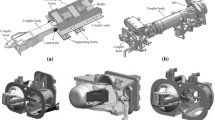Abstract
Purpose
The paper is an attempt to evaluate the impact of coupler forces in the train produced during braking. The braking signal generated from a locomotive control valve takes a few milliseconds to reach the adjoining car in coupled passenger trains. The brake comes into effect in the last car of the train after a few seconds due to the time lag. This delayed application of brakes results in pushing off the rear cars into the front cars, producing large compressive forces in the coupler. These compressive forces, mainly longitudinal in nature cause passenger discomfort and poor ride quality.
Methods
Non-linear dynamic analysis has been conducted to represent the characteristic of coupling forces between the coaches in longitudinal train dynamics. The analysis involved the mathematical model of coupler force and braking force through experimental results. In addition, effects of various braking phases, i.e., auxiliary, service and emergency braking on the in-train forces, were also investigated using ‘universal mechanism—software of dynamics of mechanical systems’.
Results
The train response due to different braking phases on the train longitudinal dynamics is thoroughly studied using multibody dynamics analysis. The results establish that the in-train forces were well within the limits prescribed by Research Design and Standard Organisation.
Conclusions
The maximum compression force increased when the forward velocity of the train is reduced during the braking phase. And, this maximum compression occurs at the third quarter of the train.










Similar content being viewed by others
References
Sharma SK, Chaturvedi S (2016) Jerk analysis in rail vehicle dynamics. Perspect Sci 8:648–650. https://doi.org/10.1016/j.pisc.2016.06.047
Jesussek M, Ellermann K (2015) Fault detection and isolation for a nonlinear railway vehicle suspension system. Adv Vibr Eng 3(6):743–758
Sharma SK, Sharma RC, Kumar A, Palli S (2015) Challenges in rail vehicle-track modeling and simulation. Int J Veh Struct Syst 7(1):1–9
Sharma SK, Kumar A (2016) Dynamics analysis of wheel rail contact using FEA. Procedia Eng 144:1119–1128. https://doi.org/10.1016/j.proeng.2016.05.076
Pugi L, Malvezzi M, Papini S, Vettori G (2013) Design and preliminary validation of a tool for the simulation of train braking performance. J Mod Transp 21:247–257
Wu Q, Luo S, Cole C (2014) Longitudinal dynamics and energy analysis for heavy haul trains. J Modern Transp 22:127–136
Kumar H, Sujatha C (2010) Analytical and experimental studies on prediction of the lateral dynamic behavior of rail bogie used in Indian railways. J Vib Eng Technol 9(2):191–205
Sharma RC, Palli S, Sharma SK, Roy M (2017) Modernization of railway track with composite sleepers. Int J Veh Struct Syst 9(5):321–329
CrĂCiun C, Mazilu T (2014) Simulation of the longitudinal dynamic forces developed in the body of passenger trains. Ann Fac Eng Hunedoara Int J Eng 12:19–26
Sharma SK, Kumar A (2017) Impact of electric locomotive traction of the passenger vehicle ride quality in longitudinal train dynamics in the context of Indian railways. Mech Ind 18(2):222. https://doi.org/10.1051/meca/2016047
Sharma SK, Kumar A (2017) Ride performance of a high speed rail vehicle using controlled semi active suspension system. Smart Mater Struct 26(5):055026. https://doi.org/10.1088/1361-665X/aa68f7
Tamboli JA (2006) Measurement of ride comfort of a vehicle: a case study. Adv Vib Eng 5(3):201–205
Kovalev R, Sakalo A, Yazykov V, Shamdani A, Bowey R, Wakeling C (2016) Simulation of longitudinal dynamics of a freight train operating through a car dumper. Veh Syst Dyn 54:707–722
Sharma SK, Kumar A (2018) Ride comfort of a higher speed rail vehicle using a magnetorheological suspension system. Proc Inst Mech Eng Part K J Multi-body Dyn 232(1):32–48. https://doi.org/10.1177/1464419317706873
Chandra K (2002) Maintenance manual for BG coaches of LHB design. Ministry of Railways, India
Swaroop A (2011) A technical note in continuation of reasoned document of EOI of AAR ‘H’type tight-lock couplers having balanced type draft gear. Research Designs and Standards Organisation, Lucknow
Sharma SK, Kumar A (2018) Disturbance rejection and force-tracking controller of nonlinear lateral vibrations in passenger rail vehicle using magnetorheological fluid damper. J Intell Mater Syst Struct 29(2):279–297. https://doi.org/10.1177/1045389X17721051
Palli S, Koona R, Sharma SK, Sharma RC (2018) Advances in dynamic analysis of rail vehicle coach. Int J Veh Struct Syst 10:3
Sharma SK, Sharma RC, Palli S (2018) Rail vehicle modeling and simulation using Lagrangian method. Int J Veh Struct Syst 10:3
Sharma SK, Sharma RC (2018) Simulation of quarter-car model with magnetorheological dampers for improving ride quality. Int J Veh Struct Syst 10:3
Jain MK (2013) Train, grade, curve and acceleration resistance, rail electric. https://www.railelectrica.com/traction-mechanics/train-grade-curve-and-acceleration-resistance-2/. Accessed 15 July 2015
12951/Mumbai Central-New Delhi Rajdhani Express (2015). http://indiarailinfo.com/. Accessed 25 Aug 2015
Indian locomotive class WAP-5 (2015) Wikipedia. https://en.wikipedia.org/wiki/Indian_locomotive_class_WAP-5/. Accessed 06 Aug 2015
Sharma SK, Kumar A (2016) The impact of a rigid-flexible system on the ride quality of passenger Bogies using a flexible carbody. In: Pombo J (ed) Proceedings of the third international conference on railway technology: research development and maintenance Stirlingshire UK 5–8 April 2016 Cagliari Sardinia Italy. Civil-Comp Press, Stirlingshire, p 87. https://doi.org/10.4203/ccp.110.87
WAP-5 and WAP-7 (2001) Tractive effort/Braking effort in Technical Data and Notes, Indian Railways, India. http://www.irfca.org/docs/index.html#tech. Accessed 12 Aug 2015
(2001) Tractive effort/Braking effort vs. Speed, Research Designs and Standards Organisation, Lucknow, India
Sharma SK, Kumar A (2014) A comparative study of Indian and Worldwide railways. Int J Mech Eng Robot Res 1(1):114–120
Kumar H, Sujatha C (2010) Ride comfort analysis of a railway vehicle moving on straight track and subjected to average vertical profile (AVP) excitation. Adv Vib Eng 9(2):119–130
Author information
Authors and Affiliations
Corresponding author
Rights and permissions
About this article
Cite this article
Sharma, S.K., Kumar, A. Impact of Longitudinal Train Dynamics on Train Operations: A Simulation-Based Study. J. Vib. Eng. Technol. 6, 197–203 (2018). https://doi.org/10.1007/s42417-018-0033-4
Received:
Revised:
Accepted:
Published:
Issue Date:
DOI: https://doi.org/10.1007/s42417-018-0033-4



